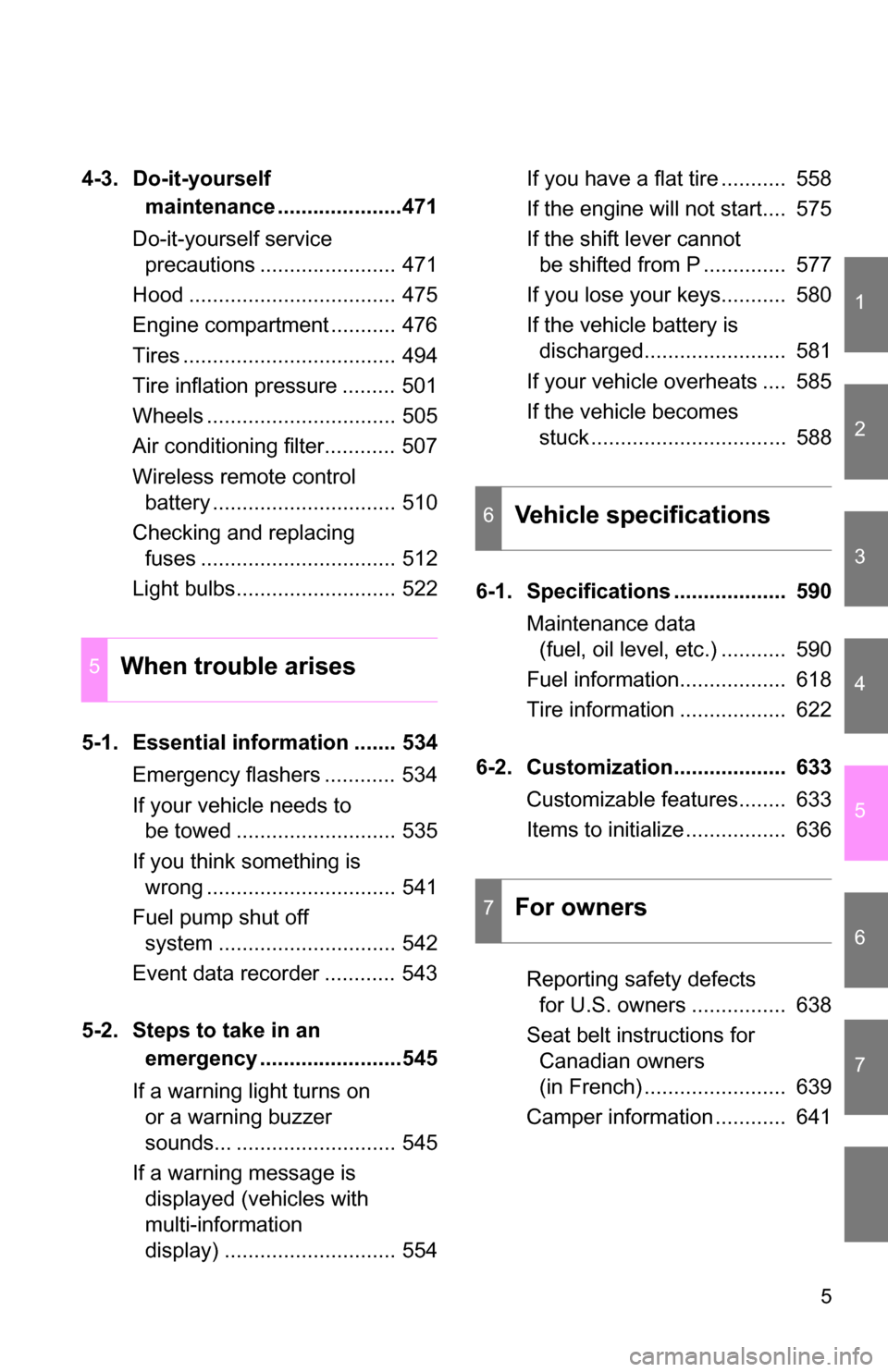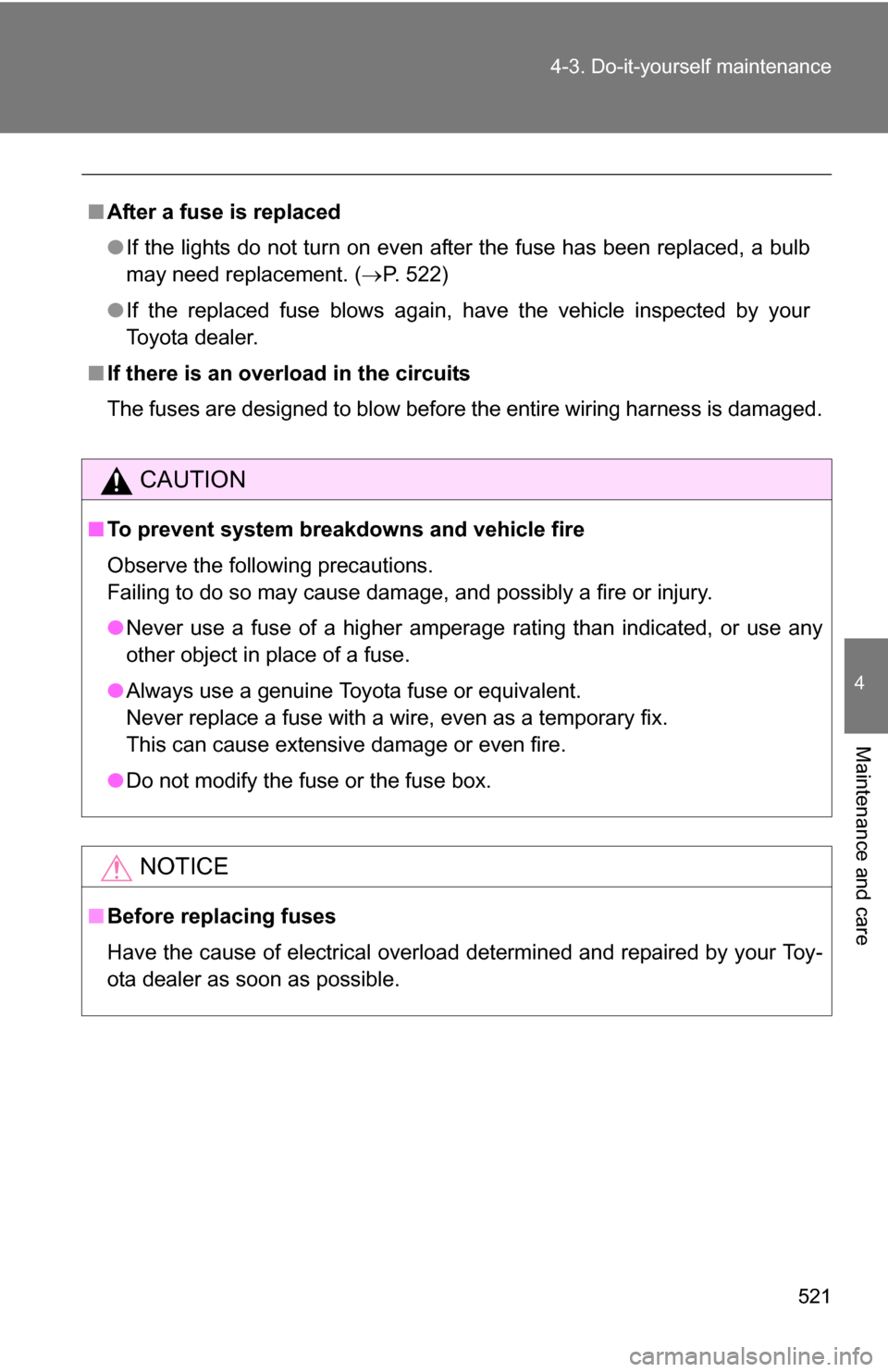Page 5 of 672

1
2
3
4
5
6
7
5
4-3. Do-it-yourself maintenance .....................471
Do-it-yourself service precautions ....................... 471
Hood ................................... 475
Engine compartment ........... 476
Tires .................................... 494
Tire inflation pressure ......... 501
Wheels ................................ 505
Air conditioning filter............ 507
Wireless remote control battery ............................... 510
Checking and replacing fuses ................................. 512
Light bulbs........................... 522
5-1. Essential information ....... 534 Emergency flashers ............ 534
If your vehicle needs to be towed ........................... 535
If you think something is wrong ................................ 541
Fuel pump shut off system .............................. 542
Event data recorder ............ 543
5-2. Steps to take in an emergency ........................545
If a warning light turns on or a warning buzzer
sounds... ........................... 545
If a warning message is displayed (vehicles with
multi-information
display) ............................. 554 If you have a flat tire ........... 558
If the engine will not start.... 575
If the shift lever cannot
be shifted from P .............. 577
If you lose your keys........... 580
If the vehicle battery is discharged........................ 581
If your vehicle overheats .... 585
If the vehicle becomes stuck ................................. 588
6-1. Specifications ................... 590 Maintenance data (fuel, oil level, etc.) ........... 590
Fuel information.................. 618
Tire information .................. 622
6-2. Customization................... 633 Customizable features........ 633
Items to initialize ................. 636
Reporting safety defects for U.S. owners ................ 638
Seat belt instructions for Canadian owners
(in French) ........................ 639
Camper information ............ 641
5When trouble arises
6Vehicle specifications
7For owners
Page 185 of 672
185
2-1. Driving procedures
2
When driving
Tur n signal lever
■Turn signals can be operated when
The engine switch is in the ON position.
■ If the indicators flash faster than usual
Check that a light bulb in the front or rear turn signal lights has not burned
out.
Left turn
Right turn
Move and hold the lever
partway to signal a lane
change.
The left hand signal will flash
until you release the lever.
Move and hold the lever
partway to signal a lane
change.
The right hand signal will flash
until you release the lever.
Page 459 of 672
Maintenance and care4
459
4-1. Maintenance and care ... 460Cleaning and protecting the vehicle exterior......... 460
Cleaning and protecting the vehicle interior.......... 462
4-2. Maintenance ................... 465 Maintenance requirements .................. 465
General maintenance....... 467
Emission inspection and maintenance (I/M)
programs........................ 470 4-3. Do-it-yourself
maintenance ................. 471
Do-it-yourself service precautions .................... 471
Hood ................................ 475
Engine compartment ........ 476
Tires ................................. 494
Tire inflation pressure ...... 501
Wheels ............................. 505
Air conditioning filter......... 507
Wireless remote control battery ............................ 510
Checking and replacing fuses .............................. 512
Light bulbs........................ 522
Page 472 of 672
472 4-3. Do-it-yourself maintenance
ItemsParts and tools
Light bulbs ( P. 522)• Bulb with same number and watt-
age rating as original
• Phillips-head screwdriver
• Flathead screwdriver
Power steering fluid level (P. 488) • Automatic transmission fluid
DEXRON
® II or III
• Rag or paper towel
Radiator and condenser (P. 486)
Tire inflation pressure (
P. 501) • Tire pressure gauge
• Compressed air source
Washer fluid
(P. 492) • Water
• Washer fluid containing antifreeze
(for winter use)
Page 521 of 672

521
4-3. Do-it-yourself maintenance
4
Maintenance and care
■
After a fuse is replaced
●If the lights do not turn on even after the fuse has been replaced, a bulb
may need replacement. ( P. 522)
● If the replaced fuse blows again, have the vehicle inspected by your
Toyota dealer.
■ If there is an overload in the circuits
The fuses are designed to blow before the entire wiring harness is damaged.
CAUTION
■To prevent system breakdowns and vehicle fire
Observe the following precautions.
Failing to do so may cause damage, and possibly a fire or injury.
●Never use a fuse of a higher amperage rating than indicated, or use any
other object in place of a fuse.
● Always use a genuine Toyota fuse or equivalent.
Never replace a fuse with a wire, even as a temporary fix.
This can cause extensive damage or even fire.
● Do not modify the fuse or the fuse box.
NOTICE
■Before replacing fuses
Have the cause of electrical overload determined and repaired by your Toy-
ota dealer as soon as possible.
Page 522 of 672
522
4-3. Do-it-yourself maintenance
Light bulbs
You may replace the following bulbs yourself. The difficulty level of
replacement varies depending on the bulb. If necessary bulb
replacement seems difficult to perfor m, contact your Toyota dealer.
For more information about replacing other light bulbs, contact your
Toyota dealer.
■ Prepare a replacement light bulb.
Check the wattage of the light bulb being replaced. ( P. 617)
■ Front bulb locations
Headlight low
beam
Front side marker
lights
Headlight
high beam Front fog lights
(if equipped)
Front turn signal/
parking lights
Page 523 of 672
523
4-3. Do-it-yourself maintenance
4
Maintenance and care
Replacing light bulbs
■ Headlight high beam
Unplug the connector while
depressing the lock release.
■Rear bulb locations
High mounted stoplight
and cargo lamps
License plate lights
Back-up lights
Rear turn
signal lights Stop/tail and rear
side marker lights
Page 524 of 672
524 4-3. Do-it-yourself maintenance
Turn the bulb base counterclock-
wise.
■ Headlight low beam
Unplug the connector while
depressing the lock release.
Turn the bulb base counterclock-
wise.